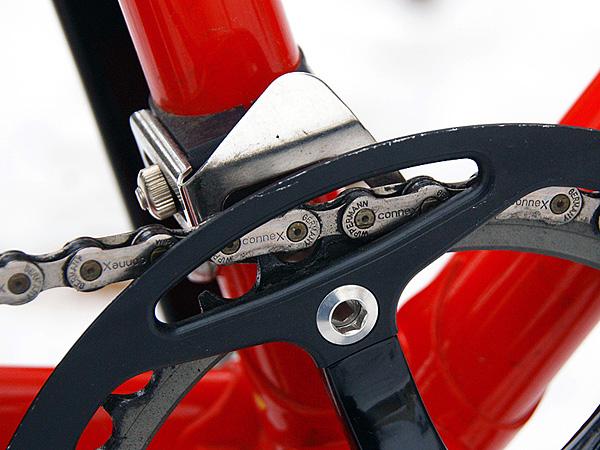By now, you may have heard SRAM XX1; and while this actually refers to a whole line-up of SRAM components, most, if not all the buzz about XX1 is revolving about the concept of using a single chain ring drivetrain on the cranks.
More to the point, the XX1 chain ring has been developed so that chainsuck* is all but a thing of the past.
SRAM went back to the drawing board on the new chain ring design and uses very precise "cut" steps to alternate thickness on every other chain ring tooth, creating a well-matched interface between each inner and outer plate of the chain itself.
This creates a "hugging" action between the chain and chain ring which helps to keep the chain in place. If you look more closely, the teeth are also taller than normal, to also help in the event the chain does become a little slack.
KING OF THE RING
Developed for maximum chain control, each tooth’s thickness is precisely CNC-machined to support the chain’s inner and outer links perfectly. Six available chain rings (28-30-32-34-36-38) allow you to tune your gear range to match your terrain, wheel size and riding style. Each X-SYNC™ chain ring fits a single, universal spider—allowing you to change rings without removing the light-weight carbon crank arm.
- New tooth profile alternates thickness by inner and outer links, providing maximum chain control
- Carbon arms with forged aluminum spider
- CNC-machined rings (28-30-32-34-36-38)
- New spider design allows for easier ring changes
- Wide/narrow Q factor cranks for BB30 and GXP
- Weight: 650 grams with BB
The reports on SRAM's XX1 chain ring set-up have been more than favorable! Over and over again folks have been able to enjoy their favorite rough terrain runs knowing that their chain will be staying put. As of the time of this write-up, we haven't yet had any personal experience with the system, but it has peaked our interest and after some research, it know on our radar.
What did people do before SRAM XX1?
 For years the mountain bike community has been dealing with chainsuck by adding gadgets to retain the chain from moving off the chain rings. IE: chainguides, N-JumpStops, etc.
For years the mountain bike community has been dealing with chainsuck by adding gadgets to retain the chain from moving off the chain rings. IE: chainguides, N-JumpStops, etc. Alternatives to SRAM XX1?
Well, yes there are some alternatives, some companies like RaceFace are now joining the party with their own versions of the "no-jump" chainring; but mostly, the main alternative is still in the form of the guides and stops linked above.
"*Chainsuck is defined as the moment your chain looses enough tension to physically jumps/drops off the crank chain rings; sometimes this means it falls to the gear below it, while other times it may jump off to the outside or inside of the chain ring landing on the frame or crank arms."
Have questions, comments, or better intel? Let us know!






